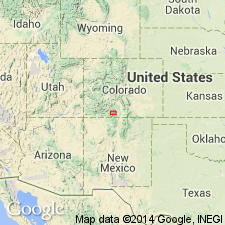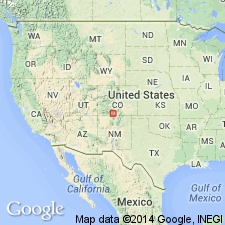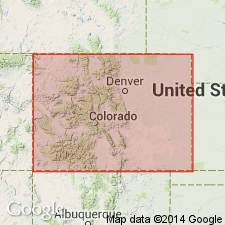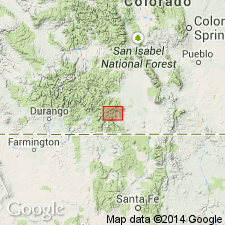
- Usage in publication:
-
- Ojito Creek Member*
- Modifications:
-
- Named
- Dominant lithology:
-
- Ash
- AAPG geologic province:
-
- San Luis basin
Summary:
Named as a member of Treasure Mountain Tuff for exposures at head of Ojito Creek, 37 deg 20 min N, 106 deg 17 min W, its type locality, about 22 km east of Platoro, Conejos Co, CO in the San Luis basin. Is a dark-brown ash-flow sheet about 20 m thick. Overlies an unnamed middle tuff and underlies Ra Jadero Member (new name). Is no more than 1 m.y. younger than the La Jara Canyon Member (29.8 m.y.), the newly named basal member of the Treasure Mountain. Has normal polarity. Assigned to the Oligocene.
Source: GNU records (USGS DDS-6; Denver GNULEX).

- Usage in publication:
-
- Ojito Creek Member*
- Modifications:
-
- Principal reference
- Dominant lithology:
-
- Tuff
- AAPG geologic province:
-
- San Luis basin
Summary:
Principal reference section designated along lower Alamosa River canyon on southwest slope of Chiquita Peak, secs 24 and 25, T36N, R6E, Conejos Co, CO in San Luis basin. Is a thin (15-30 m) widespread, single cooling-unit of quartz latitic ash-flow tuff. Black vitrophyre commonly present near base. Is densely welded and of red-brown color. Was deposited within the main Platoro caldera where it forms a sheet. Erupted from the Summitville caldera. As one of six members of Treasure Mountain Tuff is younger than the upper unit of lower tuff and older than the middle tuff. Usually overlain by Ra Jadero Member of Treasure Mountain, except for areas where it was deposited beyond the Ra Jadero. At those localities it is overlain by Masonic Park Tuff, Los Pinos or Hinsdale Formations. Western extent uncertain. Age bracketed by dates for La Jara Canyon Member of 29.8 m.y. and the Masonic Park Tuff of 28.2 m.y., suggesting 29.8 and 29.1 m.y. Has normal magnetic polarity.
Source: GNU records (USGS DDS-6; Denver GNULEX).

- Usage in publication:
-
- Ojito Creek Member*
- Modifications:
-
- Areal extent
- Overview
- AAPG geologic province:
-
- San Luis basin
- San Juan basin
- San Juan Mountains province
Summary:
Ojito Creek Member of Treasure Mountain Tuff. Areal extent of Ojito Creek in southwestern Colorado shown on distribution map; present in Mineral County (San Juan Mountain province), Rio Grande and Conejos Counties (San Luis basin), and Archuleta County (San Juan basin). Is co-extensive with the Ra Jadero Member of the Treasure Mountain. Is of quartz latite composition. Erupted from the Summitville caldera. Had an estimated volume of 40 to 70 cubic km. Age is greater than 29.1 m.y. and less than 29.8 m.y.
Source: Modified from GNU records (USGS DDS-6; Denver GNULEX).

- Usage in publication:
-
- Ojito Creek Tuff*
- Modifications:
-
- Revised
- AAPG geologic province:
-
- San Juan Mountains province
- San Juan basin
- San Luis basin
Summary:
Rank raised to a tuff of the Treasure Mountain Group (rank raised). Study area is within southeastern San Juan volcanic field, Archuleta (San Juan basin), Mineral (San Juan Mountain province), and Rio Grande and Conejos (San Luis basin) Cos, CO. Is relatively thin but widespread ash-flow sheet of densely welded silicic dacite. Estimated volume is 100 cubic km (table 1). Distribution is similar to those of underlying tuffs, except that Ojito Creek is absent on north flank of Platoro caldera complex. Rank raised because unit is as voluminous as some tuff sheets designated as formations elsewhere in San Juan volcanic field. Lipman (1975) considered source of tuffs to be Summitville caldera; however, present work weakens evidence for Summitville, instead source may be Platoro complex. Older than Ra Jadero Member (rank raised) of Treasure Mountain; younger than middle tuff of Treasure Mountain. Ar-Ar date of 29 Ma (Oligocene) (table 1).
Source: GNU records (USGS DDS-6; Denver GNULEX).
For more information, please contact Nancy Stamm, Geologic Names Committee Secretary.
Asterisk (*) indicates published by U.S. Geological Survey authors.
"No current usage" (†) implies that a name has been abandoned or has fallen into disuse. Former usage and, if known, replacement name given in parentheses ( ).
Slash (/) indicates name conflicts with nomenclatural guidelines (CSN, 1933; ACSN, 1961, 1970; NACSN, 1983, 2005, 2021). May be explained within brackets ([ ]).

